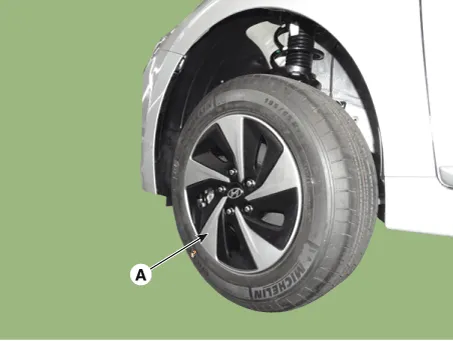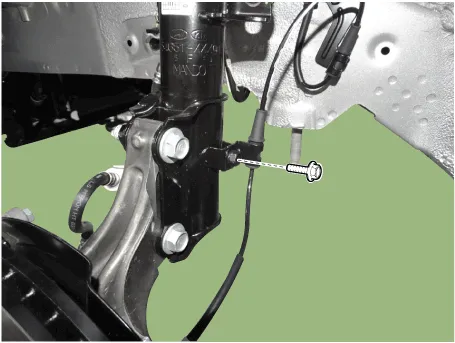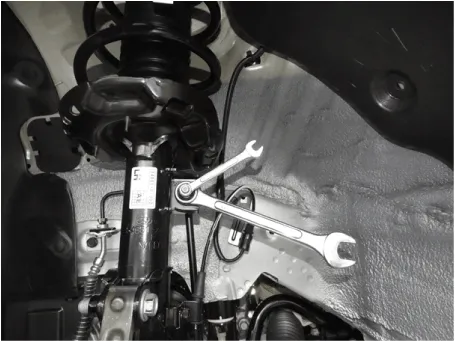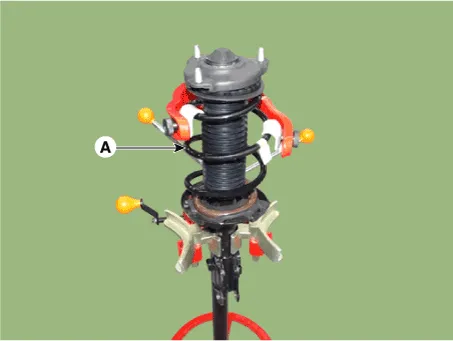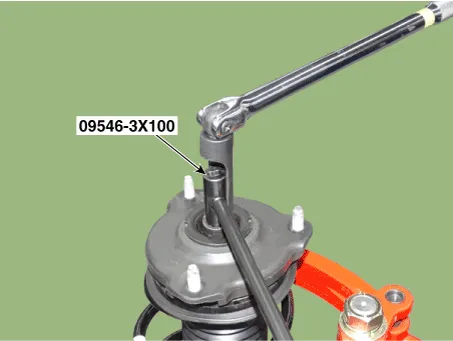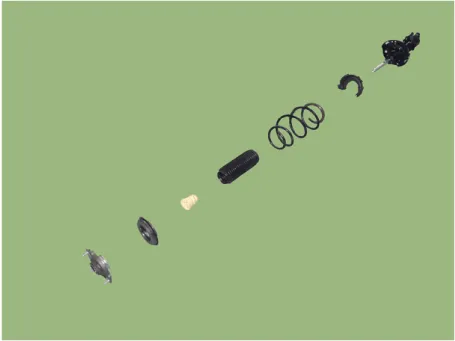Hyundai Ioniq (AE): Front Suspension System / Front Strut Assembly. Repair procedures
| Removal |
| 1. | Loosen the wheel nuts slightly. Raise the vehicle, and make sure it is securely supported. |
| 2. | Remove the front wheel and tire (A) from the front hub.
|
| 3. | Loosen the brake hose mounting bolt and then remove the brake hose bracket.
|
| 4. | Loosen the mounting holt and then remove the brake hose from the strut assembly.
|
| 5. | Disconnect the stabilizer link with the front strut assembly after loosening the nut.
|
| 6. | Remove the cowl top cover. (Refer to Body - "Cowl Top Cover") |
| 7. | Loosen the upper strut mounting nut (A).
|
| 8. | Remove the front strut assembly (A) from the front axle (B) by loosening the bolts & nuts.
|
| 9. | Install in the reverse order of removal. |
| Disassembly |
|
| 1. | Using spring comperssor, compress the coil spring (A)
|
| 2. | Using the special tool (09546-3X100), remove the self locking nut.
|
| 3. | Remove the insulator, strut bearing, coil spring and dust cover from the strut assembly.
|
| Inspection |
| 1. | Check the strut bearing for wear and damage. |
| 2. | Check the spring upper and lower pad for damage and deterioration. |
| 3. | Compress and extend the piston rod (A) and check that there is no abnormal resistance or unusual sound during operation.
|
| Disposal |
| 1. | Fully extend the piston rod. |
| 2. | Drill a hole on the (A) section to remove gas from the cylinder.
|
| Reassembly |
| 1. | Install in the reverse order of removal. |
| 2. | Compress and extend the piston rod (A) and check that there is no abnormal resistance or unusual sound during operation.
|
| 3. | Using the special tool (09546-3X100), install the self locking nut.
|
Components1. Strut assembly2. Lock nut3. Insulator 4. Strut bearing & Spring upper pad5. Bumper rubber6. Dust cover7. Coli spring8. Spring lower pad
Removal1.Loosen the wheel nuts slightly.Raise the vehicle, and make sure it is securely supported.2.Remove the front wheel and tire (A) from the front hub.
Other information:
Hyundai Ioniq (AE) 2017-2022 Service & Repair Manual: PTC Heater. Description and operation
DescriptionThe PTC (Positive Temperature Coefficient) heater is installed at the exit or the backside of the heater core.The PTC heater is an electric heater using a PTC element as an auxiliary heating device that supplements deficiency of interior heat source in highly effective hybrid engine.
Hyundai Ioniq (AE) 2017-2022 Service & Repair Manual: Description and operation
DescriptionThe smart cruise control system allows a driver to program the vehicle to control the speed and following distance by detecting the vehicle ahead without depressing the brake pedal and the accelerator pedal.1.Cruise speed control : The vehicle maintains the selected speed if there are not vehicles ahead.
Categories
- Manuals Home
- Hyundai Ioniq Owners Manual
- Hyundai Ioniq Service Manual
- Driving your vehicle
- Your vehicle at a glance
- Important safety precautions
- New on site
- Most important about car

